2014 CHRYSLER TOWN AND COUNTRY radiator cap
[x] Cancel search: radiator capPage 566 of 703
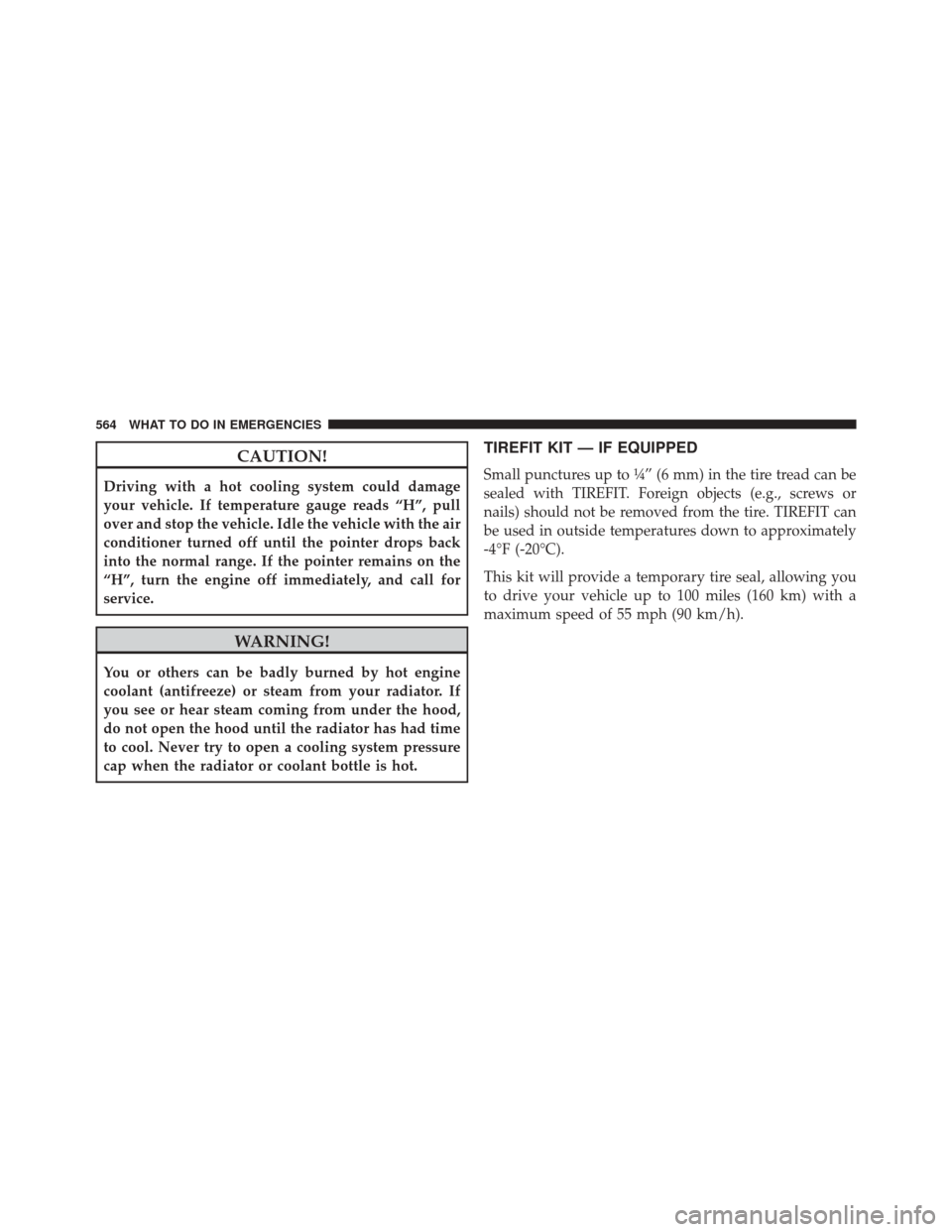
CAUTION!
Driving with a hot cooling system could damage
your vehicle. If temperature gauge reads “H”, pull
over and stop the vehicle. Idle the vehicle with the air
conditioner turned off until the pointer drops back
into the normal range. If the pointer remains on the
“H”, turn the engine off immediately, and call for
service.
WARNING!
You or others can be badly burned by hot engine
coolant (antifreeze) or steam from your radiator. If
you see or hear steam coming from under the hood,
do not open the hood until the radiator has had time
to cool. Never try to open a cooling system pressure
cap when the radiator or coolant bottle is hot.
TIREFIT KIT — IF EQUIPPED
Small punctures up to ¼” (6 mm) in the tire tread can be
sealed with TIREFIT. Foreign objects (e.g., screws or
nails) should not be removed from the tire. TIREFIT can
be used in outside temperatures down to approximately
-4°F (-20°C).
This kit will provide a temporary tire seal, allowing you
to drive your vehicle up to 100 miles (160 km) with a
maximum speed of 55 mph (90 km/h).
564 WHAT TO DO IN EMERGENCIES
Page 628 of 703
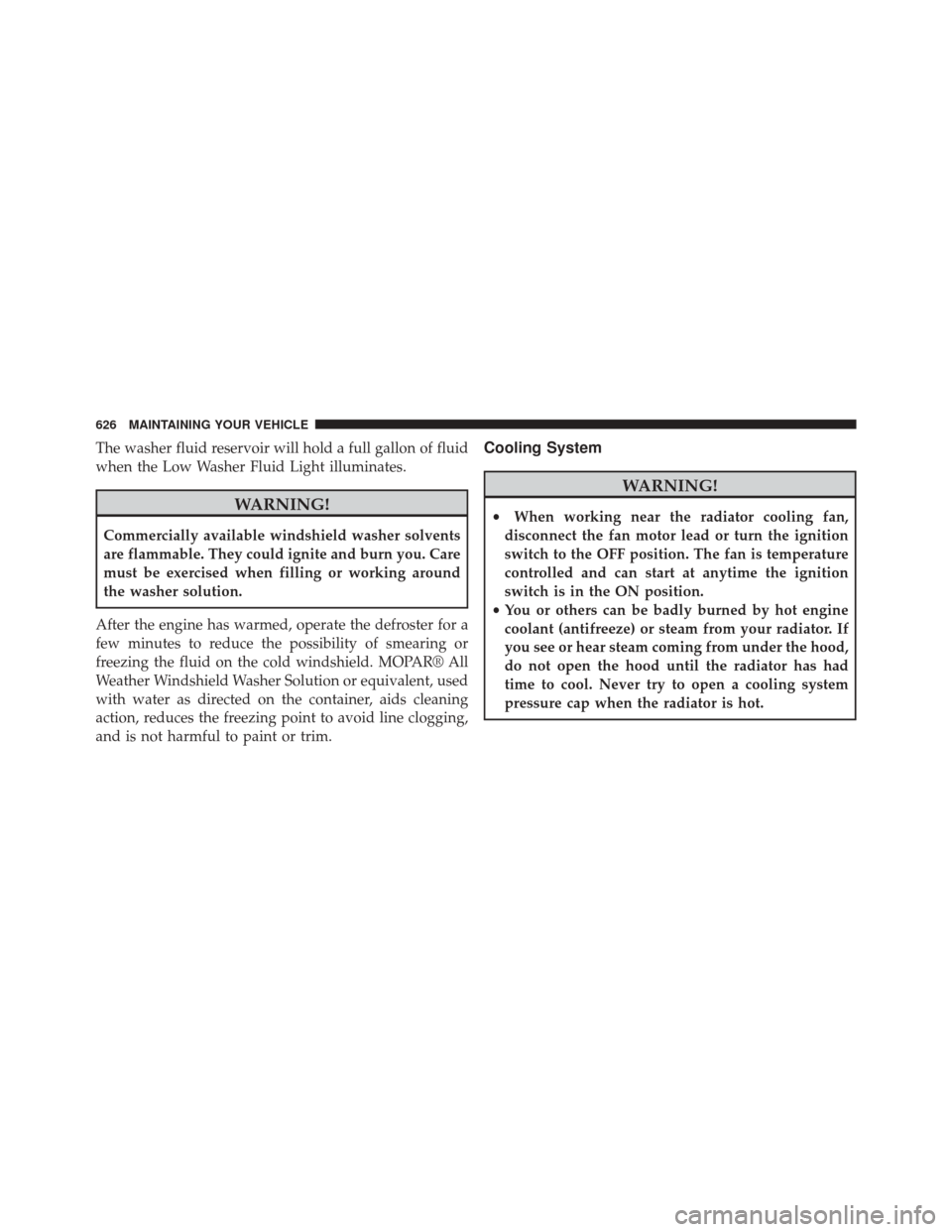
The washer fluid reservoir will hold a full gallon of fluid
when the Low Washer Fluid Light illuminates.
WARNING!
Commercially available windshield washer solvents
are flammable. They could ignite and burn you. Care
must be exercised when filling or working around
the washer solution.
After the engine has warmed, operate the defroster for a
few minutes to reduce the possibility of smearing or
freezing the fluid on the cold windshield. MOPAR® All
Weather Windshield Washer Solution or equivalent, used
with water as directed on the container, aids cleaning
action, reduces the freezing point to avoid line clogging,
and is not harmful to paint or trim.
Cooling System
WARNING!
• When working near the radiator cooling fan,
disconnect the fan motor lead or turn the ignition
switch to the OFF position. The fan is temperature
controlled and can start at anytime the ignition
switch is in the ON position.
• You or others can be badly burned by hot engine
coolant (antifreeze) or steam from your radiator. If
you see or hear steam coming from under the hood,
do not open the hood until the radiator has had
time to cool. Never try to open a cooling system
pressure cap when the radiator is hot.
626 MAINTAINING YOUR VEHICLE
Page 629 of 703
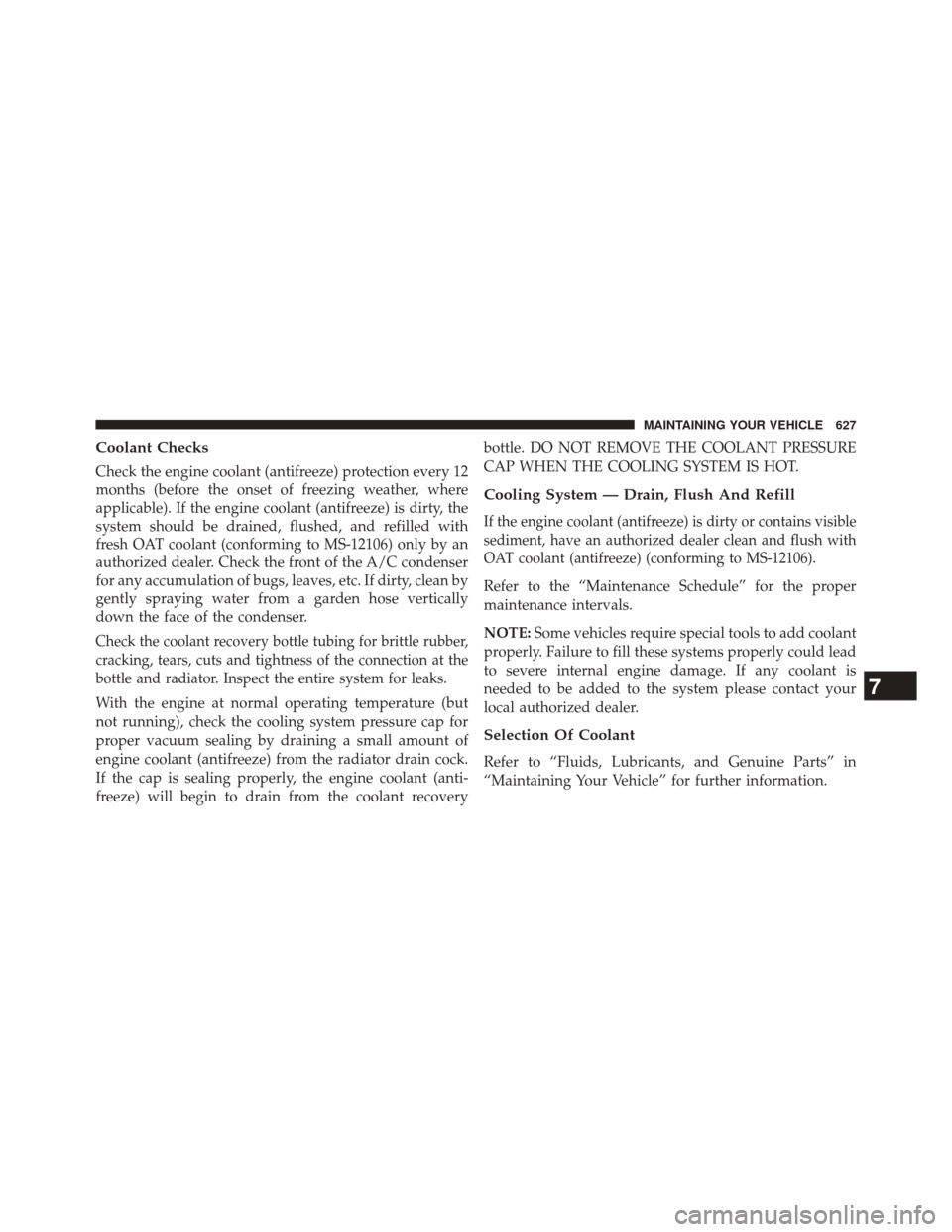
Coolant Checks
Check the engine coolant (antifreeze) protection every 12
months (before the onset of freezing weather, where
applicable). If the engine coolant (antifreeze) is dirty, the
system should be drained, flushed, and refilled with
fresh OAT coolant (conforming to MS-12106) only by an
authorized dealer. Check the front of the A/C condenser
for any accumulation of bugs, leaves, etc. If dirty, clean by
gently spraying water from a garden hose vertically
down the face of the condenser.
Check the coolant recovery bottle tubing for brittle rubber,
cracking, tears, cuts and tightness of the connection at the
bottle and radiator. Inspect the entire system for leaks.
With the engine at normal operating temperature (but
not running), check the cooling system pressure cap for
proper vacuum sealing by draining a small amount of
engine coolant (antifreeze) from the radiator drain cock.
If the cap is sealing properly, the engine coolant (anti-
freeze) will begin to drain from the coolant recoverybottle. DO NOT REMOVE THE COOLANT PRESSURE
CAP WHEN THE COOLING SYSTEM IS HOT.
Cooling System — Drain, Flush And Refill
If the engine coolant (antifreeze) is dirty or contains visible
sediment, have an authorized dealer clean and flush with
OAT coolant (antifreeze) (conforming to MS-12106).
Refer to the “Maintenance Schedule” for the proper
maintenance intervals.
NOTE:
Some vehicles require special tools to add coolant
properly. Failure to fill these systems properly could lead
to severe internal engine damage. If any coolant is
needed to be added to the system please contact your
local authorized dealer.
Selection Of Coolant
Refer to “Fluids, Lubricants, and Genuine Parts” in
“Maintaining Your Vehicle” for further information.
7
MAINTAINING YOUR VEHICLE 627
Page 632 of 703

•Mixing engine coolant (antifreeze) types is not recom-
mended and can result in cooling system damage. If
HOAT and OAT coolant are mixed in an emergency,
have a authorized dealer drain, flush, and refill with
OAT coolant (conforming to MS-12106) as soon as
possible.
Cooling System Pressure Cap
The cap must be fully tightened to prevent loss of engine
coolant (antifreeze), and to ensure that engine coolant
(antifreeze) will return to the radiator from the coolant
recovery tank.
The cap should be inspected and cleaned if there is any
accumulation of foreign material on the sealing surfaces.
WARNING!
• Do not open hot engine cooling system. Never add
engine coolant (antifreeze) when the engine is
overheated. Do not loosen or remove the cap to cool
an overheated engine. Heat causes pressure to
build up in the cooling system. To prevent scalding
or injury, do not remove the pressure cap while the
system is hot or under pressure.
• Do not use a pressure cap other than the one
specified for your vehicle. Personal injury or en-
gine damage may result.
630 MAINTAINING YOUR VEHICLE
Page 633 of 703
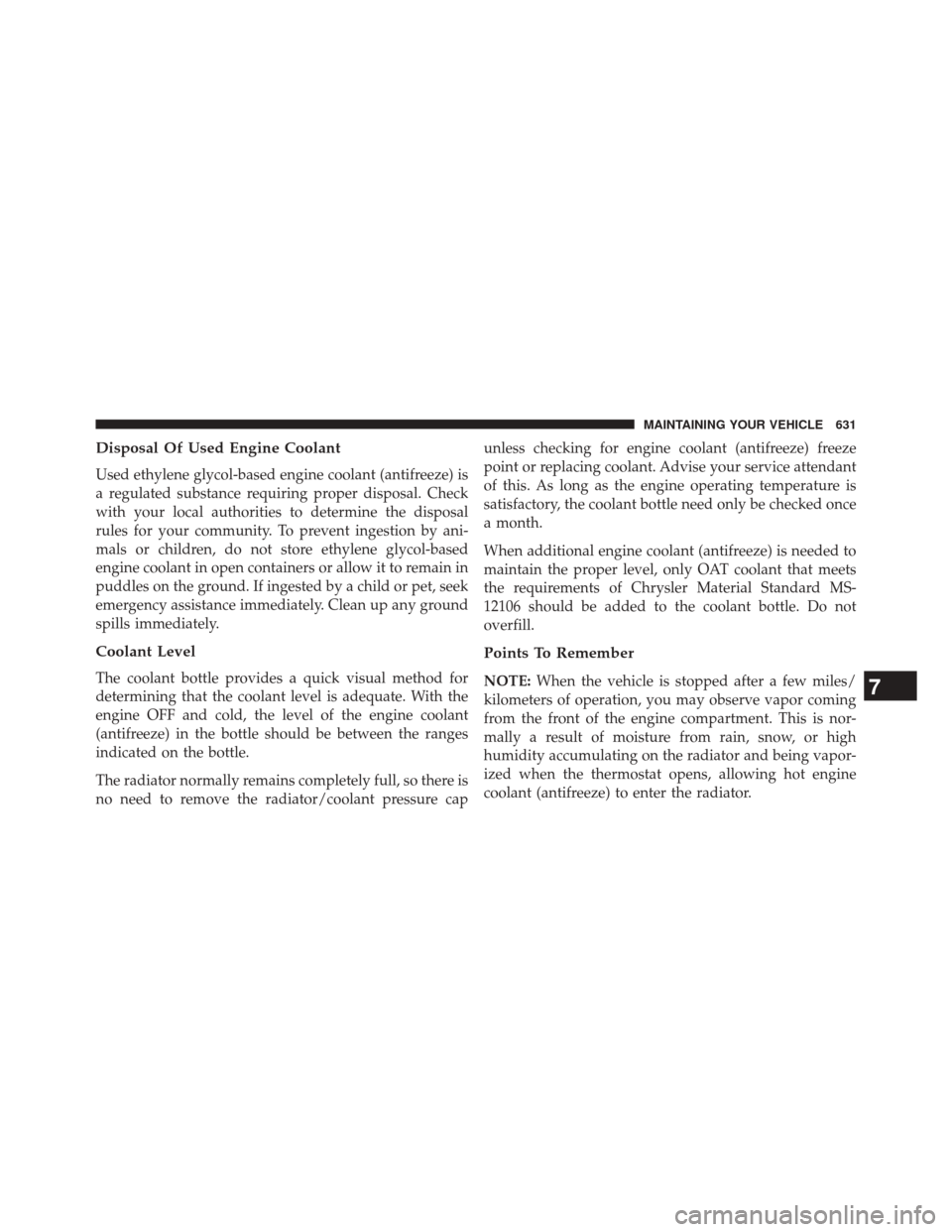
Disposal Of Used Engine Coolant
Used ethylene glycol-based engine coolant (antifreeze) is
a regulated substance requiring proper disposal. Check
with your local authorities to determine the disposal
rules for your community. To prevent ingestion by ani-
mals or children, do not store ethylene glycol-based
engine coolant in open containers or allow it to remain in
puddles on the ground. If ingested by a child or pet, seek
emergency assistance immediately. Clean up any ground
spills immediately.
Coolant Level
The coolant bottle provides a quick visual method for
determining that the coolant level is adequate. With the
engine OFF and cold, the level of the engine coolant
(antifreeze) in the bottle should be between the ranges
indicated on the bottle.
The radiator normally remains completely full, so there is
no need to remove the radiator/coolant pressure capunless checking for engine coolant (antifreeze) freeze
point or replacing coolant. Advise your service attendant
of this. As long as the engine operating temperature is
satisfactory, the coolant bottle need only be checked once
a month.
When additional engine coolant (antifreeze) is needed to
maintain the proper level, only OAT coolant that meets
the requirements of Chrysler Material Standard MS-
12106 should be added to the coolant bottle. Do not
overfill.
Points To Remember
NOTE:
When the vehicle is stopped after a few miles/
kilometers of operation, you may observe vapor coming
from the front of the engine compartment. This is nor-
mally a result of moisture from rain, snow, or high
humidity accumulating on the radiator and being vapor-
ized when the thermostat opens, allowing hot engine
coolant (antifreeze) to enter the radiator.7
MAINTAINING YOUR VEHICLE 631
Page 685 of 703
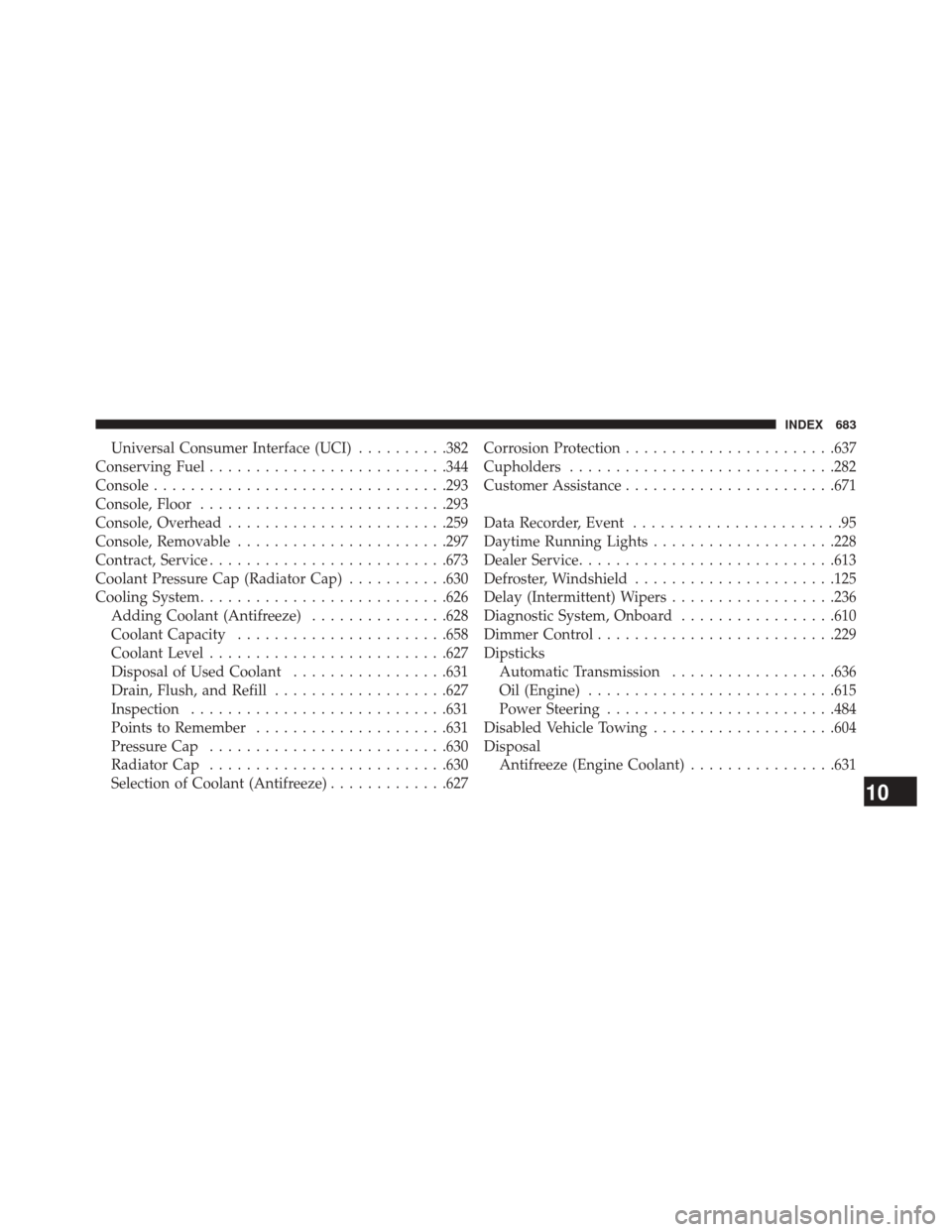
Universal Consumer Interface (UCI)..........382
Conserving Fuel ......................... .344
Console ............................... .293
Console, Floor .......................... .293
Console, Overhead ....................... .259
Console, Removable ...................... .297
Contract, Service ......................... .673
Coolant Pressure Cap (Radiator Cap) ...........630
Cooling System .......................... .626
Adding Coolant (Antifreeze) ...............628
Coolant Capacity ...................... .658
Coolant Level ......................... .627
Disposal of Used Coolant .................631
Drain, Flush, and Refill ...................627
Inspection ........................... .631
Points to Remember .....................631
Pressure Cap ......................... .630
Radiator Cap ......................... .630
Selection of Coolant (Antifreeze) .............627Corrosion Protection
...................... .637
Cupholders ............................ .282
Customer Assistance ...................... .671
Data Recorder, Event .......................95
Daytime Running Lights ....................228
Dealer Service ........................... .613
Defroster, Windshield ..................... .125
Delay (Intermittent) Wipers ..................236
Diagnostic System, Onboard .................610
Dimmer Control ......................... .229
Dipsticks Automatic Transmission ..................636
Oil (Engine) .......................... .615
Power Steering ........................ .484
Disabled Vehicle Towing ....................604
Disposal Antifreeze (Engine Coolant) ................631
10
INDEX 683
Page 694 of 703
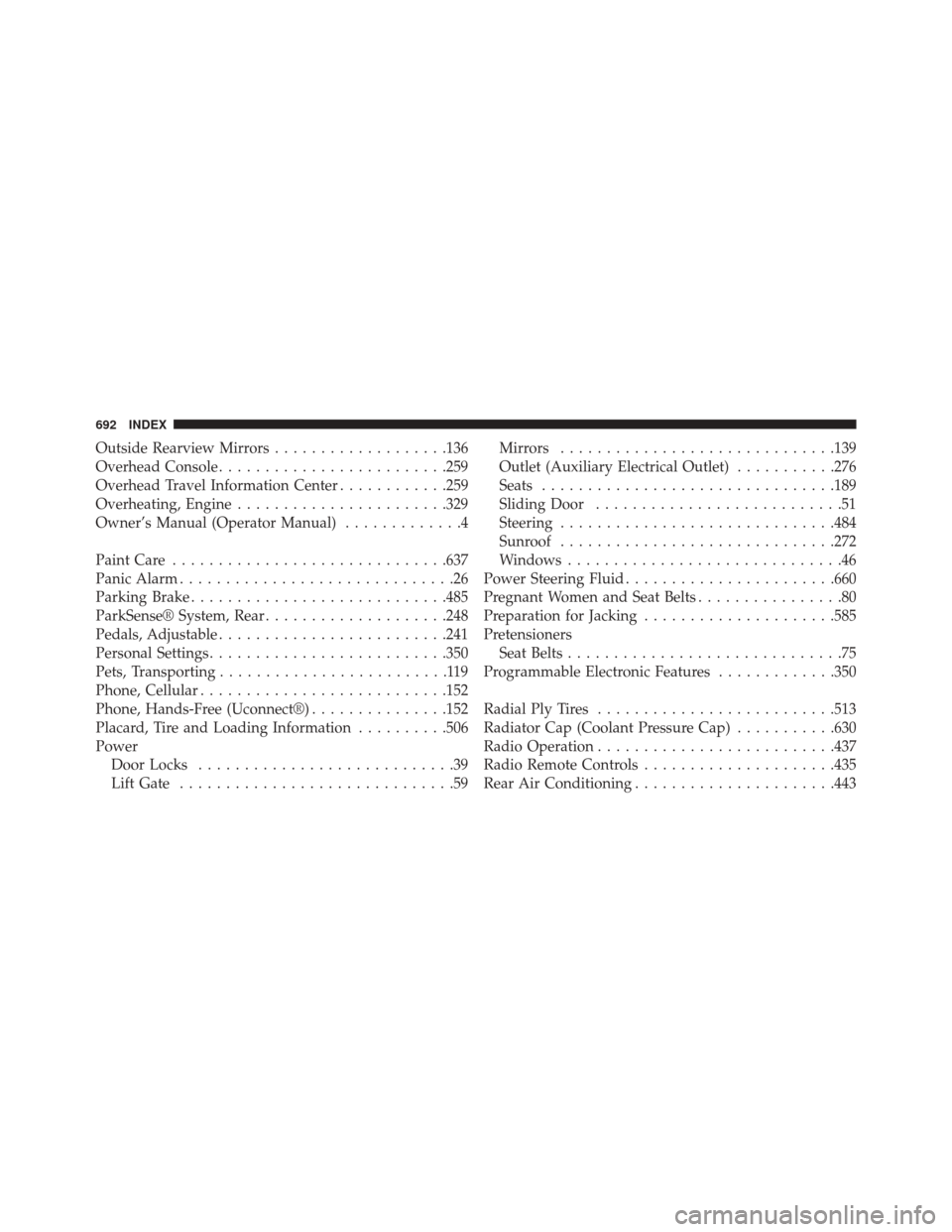
Outside Rearview Mirrors...................136
Overhead Console ........................ .259
Overhead Travel Information Center ............259
Overheating, Engine ...................... .329
Owner’s Manual (Operator Manual) .............4
Paint Care ............................. .637
Panic Alarm ..............................26
Parking Brake ........................... .485
ParkSense® System, Rear ....................248
Pedals, Adjustable ........................ .241
Personal Settings ......................... .350
Pets, Transporting .........................119
Phone, Cellular .......................... .152
Phone, Hands-Free (Uconnect®) ...............152
Placard, Tire and Loading Information ..........506
Power Door Locks ............................39
Lift Gate ..............................59 Mirrors
............................. .139
Outlet (Auxiliary Electrical Outlet) ...........276
Seats ............................... .189
Sliding Door ...........................51
Steering ............................. .484
Sunroof ............................. .272
Windows ..............................46
Power Steering Fluid ...................... .660
Pregnant Women and Seat Belts ................80
Preparation for Jacking .....................585
Pretensioners Seat Belts ..............................75
Programmable Electronic Features .............350
Radial Ply Tires ......................... .513
Radiator Cap (Coolant Pressure Cap) ...........630
Radio Operation ......................... .437
Radio Remote Controls .....................435
Rear Air Conditioning ..................... .443
692 INDEX